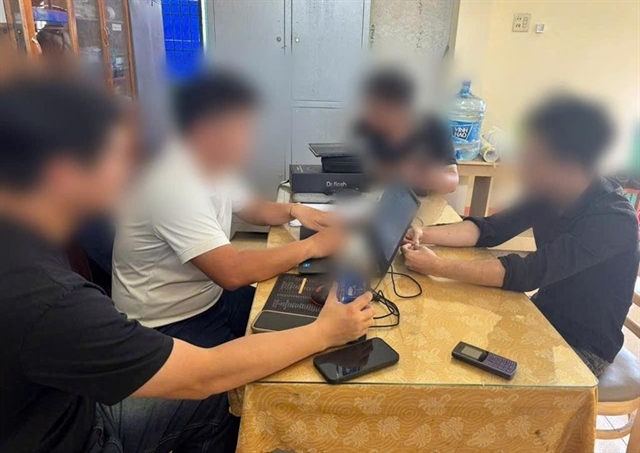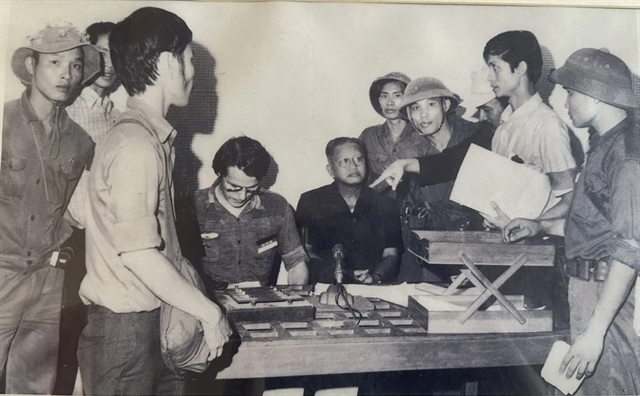 Society
Society

 |
| Dương Văn Minh, President of the Republic of Vietnam (sitting, wearing a black shirt and looking up), about to read a statement of surrender at Sài Gòn Radio at noon on April 30, 1975. — VNA/VNS Photo |
HCM CITY — In the lead-up to Việt Nam’s 50th anniversary of national reunification, the skies above HCM City thunder with the roar of modern fighter jets rehearsing for the upcoming celebration.
Yet for those who once marched into the heart of Sài Gòn five decades ago, it is not the sound of engines but the echoes of memories that resonate most powerfully.
Among them is Phan Thi Bé Tư, born in 1946, a former member of the Armed Communication Unit under the T4 Public Mobilisation Committee in Sài Gòn. A former Côn Đảo political prisoner, she calls April 30, 1975, as "the most beautiful day" of her life.
After enduring five years in prisons she described as "hell on earth" built by the US and South Vietnamese regime, Bé Tư was released in March 1974 under the Paris Peace Accords and reassigned to Tiền Giang, where she joined preparations for the final assault — the Hồ Chí Minh Campaign.
"At 8 am on April 30, we marched toward Sài Gòn to take over District 2's municipal government," she recalled.
"All along the road, we saw soldiers of the puppet regime abandoning their uniforms and weapons, fleeing in panic."
By noon, her unit entered a Sài Gòn largely untouched by the final battles. "People welcomed us like long-lost family," she said.
At Bến Thành Market, she climbed onto the rooftop to plant the national flag. "The people were overjoyed. They brought us food and water. It was deeply moving," she said through tears.
But even in that moment of euphoria, grief lingered. "I remembered my younger brother, who died in 1967, and comrades lost to prisons or the battlefield. Many never made it back from Côn Đảo."
Nguyễn Thị Nè, born in 1945 and a member of the A20 unit of the Liberation Army, was tasked with receiving surrendered enemy troops in District 2. As victory unfolded, she too wept.
"I remembered being locked in the 'tiger cages' of Côn Đảo, tortured, but always believing the revolution would triumph," she said.
Her mind turned to her home in Củ Chi, reduced to ruins by B-52 bombings and chemical defoliants. "Out of ten homes, nine had collapsed. My own was bombed. So many became martyrs."
Phùng Bá Đam, then a First Lieutenant with Regiment 66 of Division 304 under Corps 2, was among those who entered the Independence Palace at 11:30am on April 30.
After fierce battles at strategic southern points, his unit penetrated the city’s eastern defences. He accompanied Captain Phạm Xuân Thệ and others in escorting South Vietnamese President Dương Văn Minh to Sài Gòn Radio, where he declared unconditional surrender.
"It was an immense honour," Đam said. "But in the joy of reunification, I thought of comrades who fell in Quảng Trị, on Hill 1062 at Thượng Đức, and right at Sài Gòn’s gates."
Reflecting on the near-intact state of Sài Gòn at the time of its liberation, Nguyễn Huy Hiệu, former Deputy Minister of Defence and a hero of the People's Armed Forces, emphasised the strategic design of the campaign.
"We combined military, political and diplomatic strength and planned carefully for post-war reconstruction. Our doctrine of 'speed, surprise, boldness, and certain victory' meant bypassing outer defences and heading straight for the core."
This doctrine preserved Sài Gòn, minimised casualties and fulfilled the wish of President Hồ Chí Minh: "Defeat the Americans, topple the puppet regime, and reunite North and South — no spring could be happier."
"All forces tasked with securing Sài Gòn were under strict orders to protect assigned areas, safeguard public property and prevent looting," Hiệu said.
"We stabilised not just territory but the hearts of the people. That unity of soldiers and citizens was the foundation of our success. Without the people, we could have done nothing. With them, we achieved everything."
As the nation prepares to commemorate the 50th anniversary of that momentous day, the stories of those who lived it — both triumphant and tragic — resound more than any jet engine. Their tears, still flowing, are reminders of the price and power of peace. — VNS




